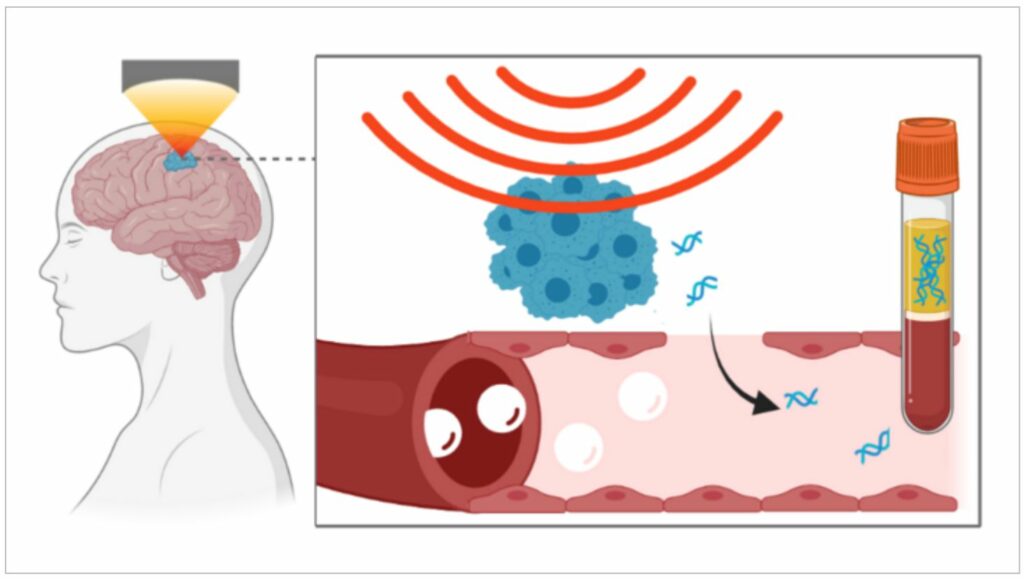Tau proteins are a hallmark of a number of neurodegenerative disorder disorders, including Alzheimer’s disease and dementia.
Researchers are trying to figure out how these tau proteins work in order to create therapies, but their attempts to discover biomarkers in blood have been impeded by the protective blood-brain barrier.
In a recent study conducted at Washington University in St. Louis, associate professor of radiation oncology and biomedical engineering Hong Chen’s lab discovered that focused-ultrasound-mediated liquid biopsy increased the release of tau proteins and another biomarker into the blood compared to that of a control group of mice. The researchers said that this noninvasive method could help doctors figure out what’s wrong with people with neurodegenerative diseases.
The approach, referred to as sonobiopsy, employs targeted ultrasound to target a specific area of the brain. Once the area is found, the researchers inject tiny bubbles into the blood. These bubbles travel to the tissue that was targeted by the ultrasound and pulse. This opens the blood-brain barrier in a safe way.
Biomarkers like tau proteins and neurofilament light chain protein (NfL), which are both signs of neurodegenerative disorders, can get through the blood-brain barrier and into the blood through these temporary gaps.
Chen collaborated with co-senior author Arash Nazeri, MD, an assistant professor of radiology at the Mallinckrodt Institute of Radiology at the School of Medicine (MIR).
They worked with first author Christopher Pham Pacia, who recently received his doctorate in biomedical engineering from Washington University; Jinyun Yuan, a research scientist in C; Tammie LS Benzinger, MD, PhD, a professor of radiology at MIR and a professor of neurological surgery, biology, and biological sciences; Eric Leuthardt, MD, a professor of neurosurgery at the School of Medicine and of biomedical engineering at McKelvey Engineering; and Jinyun
The study’s findings, the first to employ focused ultrasound to mediate liquid biopsy for noninvasive and targeted diagnosis and monitoring of neurodegenerative diseases, were published in Radiology today.
Chen, Leuthardt, Pacia, and others have been working on the sonobiopsy method for a number of years. At first, they used biomarkers for human brain cancer in preclinical models to test the method.
Detecting biomarkers for neurodegenerative illnesses using other liquid biopsy techniques presents a number of difficulties, including a lack of anatomical information on the site of protein release, fast fluid clearance, and blood-brain barrier filtering.
Sonobiopsy, according to Chen, is a new technology that has the ability to handle these and other problems.
In the latest study, the scientists first collected blood samples from young mice who had tauopathy, or aberrant tau proteins in the brain, either after getting sonobiopsy or a sham procedure.

They discovered that, in comparison to the control mice group that had not undergone sonobiopsy, sonobiopsy caused a 1.7-fold rise in the normalized phosphorylated pTau-181 tau protein levels as well as a 1.4-fold increase in normalized pTau-231 tau protein levels.
In a subsequent investigation, they targeted the hippocampus or cerebral cortex in the early neurodegenerative phases of the tauopathy model, conducted targeted sonobiopsy, and collected blood samples before and after sonobiopsy.
The targeted sonobiopsy led to 2.3 times more NfL protein in the treated mice than in the control group. NfL protein is a secondary biomarker for neurodegenerative diseases.
“In our proof-of-concept study, we sought to determine whether sonobiopsy is able to release phosphorylated tau species and NfL into the bloodstream by opening the blood-brain barrier,” Chen adds. “This demonstration showed that sonobiopsy significantly enhanced the release of pTau proteins and a secondary marker of neurodegeneration into the bloodstream for noninvasive diagnosis for neurodegenerative diseases.”
Nazeri said that tauopathies like Alzheimer’s are like brain tumors.
“While brain tumor behavior and treatment response are dictated by the specific mutations they harbor, the tau protein shows great heterogeneity in the pattern of phosphorylation as well as other post-translational modifications,” Nazeri adds. “Current PET imaging and recently developed plasma biomarkers are sensitive to detect tauopathies even in early stages. Sonobiopsy could potentially play a role to further characterize the specific strains of tau protein present in the brain for personalized treatment of people with Alzheimer’s disease and other tauopathies.”
In the future, the team will investigate the qualitative impacts of sonobiopsy on plasma biomarkers, describe the effects of targeted ultrasonic parameters, ascertain the ideal blood collection duration, and discover how sonobiopsy may be utilized to release bigger brain-derived protein biomarkers.
Image Credit: Getty
